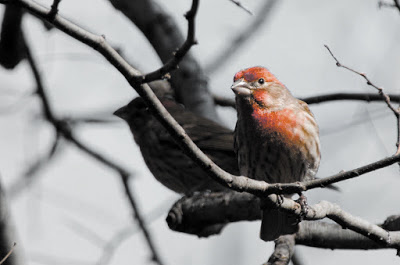 |
| It has
been raining and gray here for days that feel like weeks. It seems to
make the red cardinals stand out even more than usual. Click to enlarge.
|
It reminds me of something Terri Guillemets wrote:
"Winter is the slow-down
Winter is the search for self
Winter gives the silence you need to listen
Winter goes gray so you can see your own colors..."
On the technical side, when I was picturing red cardinals on gray backgrounds, I realized that although my camera can take a selectively colored photograph like that, I did not know how to change an existing color image to only show reds and grays. I figured
out how to do it with Photoshop. (I have CS 5.) I opened this jpg and
called it Layer 1. Then I chose Color Range from the Selection menu, and
then Reds from the Selected Colors pull down. I copied that selection
to a new layer. Then I used the Adjustment option from the Image menu to
change Layer 1 to Black and White. That's it. Red cardinals on gray
backgrounds.
 |
| Works well for house finches, too. |













